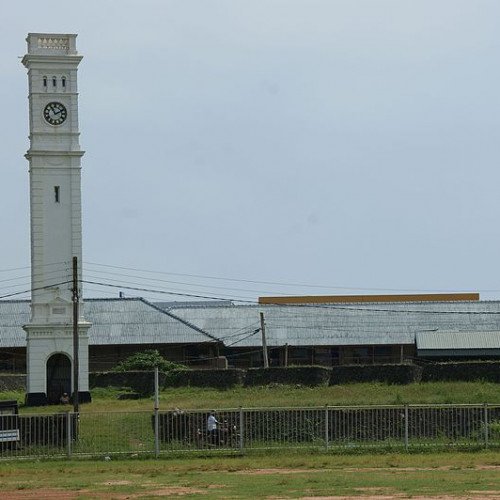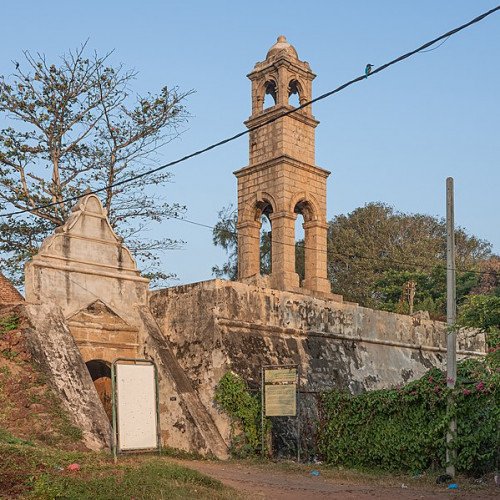Castles of "Sri Lanka" MATARA FORT vs NEGOMBO FORT

MATARA FORT
The Matara Fort (Sinhala: මාතර බලකොටුව Mathara Balakotuwa; Tamil: மாத்தறைக் கோட்டை, romanized: Māttaṟaik Kōṭṭai) was built in 1560 by the Portuguese and was substantially re-built by the Dutch in 1640, following the capture of Galle. The fort, which consists of a large stone rampart, occupies the promontory, which separates the Niwala Ganga (River) lagoon and the ocean. The Portuguese constructed the first fortifications in 1595, with the assistance of Don Juan Dharmapala, the ruler of the Kingdom of Kotte. In 1640 the Dutch captured Matara from the Portuguese, and in 1645 they were responsible for the construction of the current fortifications. The fort consists of a 240 m (790 ft) long, 13 m (43 ft) thick, 5 m (16 ft) high rampart and the gateway constructed from local limestone, granite and coral. The rampart originally had a ditch in front of it, two half bastion projections at each end and a larger projection in the centre close to the gate with a bridge across the ditch. It was built to protect the administrative buildings of VOC (Dutch East India Company), who were attracted by the deep and sheltered estuary of the Nilwala Ganga, making Matara an important centre for cinnamon and elephant trading. During the 'Matara Rebellion' of 1761, the fort was captured by Kirti Sri Rajasinha's Kandyan army that bombarded the town with cannonballs that went over the wall. After spiking their own cannon and destroying their ammunition and provisions, the garrison was evacuated by two ships that were waiting at sea. The Dutch recaptured the fort on 2 February 1762, finding eight cannon on the walls, including an English one. During the Dutch rule the District Secretary's house, the cinnamon, areca nut, gunpowder storage and an elephant kraal (containing four elephant stables, which could house up to 80 elephants and a tank where the elephants were washed) were constructed within the fort. The oldest building within the fort is the Dutch Reformatory Church, which is situated near the entrance. It was built by the Dutch in 1706 the date however etched above the entrance, 1767, refers to the reconstruction of the church by the Dutch following the Matara Rebellion. The door and window panels are made of heavy wood while the walls now show signs of crumbling as the proper mixture to rebuild them could not be found within Sri Lanka. Inside are gravestones on the floor dating back to 1686, of significant community members and beneficiaries of their time.
Statistics for this Xoptio

NEGOMBO FORT
Negombo Fort (Sinhala: මීගමුව බලකොටුව, romanized: Migamuwa Balakotuwa; Tamil: நீர்கொழும்புக் கோட்டை, romanized: Nīrkoḻumpuk Kōṭṭai) was a small but important fort in Negombo, approx. 30 km (19 mi) north of Colombo, that was built by the Portuguese to defend Colombo. In its time the fort at Negombo was probably the next in strategic importance after Colombo, Jaffna and Galle. The original Portuguese fort was a weak structure, which, according to the account of João Ribeyro; "Negombo was only a square enclosed by walls, with two redoubts and five guns. A Captain and a few men, with a Chaplain were stationed there" It was captured by Dutch forces commanded by Philip Lucasz, in February 1640. The Portuguese made several attempts to retake it before they were successful in December 1643. They then strengthened the fortifications and managed to defend the fort until it was recaptured by the Dutch under the command of François Caron, in January 1644. The original bastions were destroyed by the Dutch cannons during the siege of the fort. The Dutch subsequently rebuilt it in 1672 however not on the usual square pattern, but on a pentagonal one, though it had only four bulwarks, the fifth was never constructed (possibly due to the cost). The fort was located on a narrow strip of land between a lagoon and an inlet of the sea. It was surrounded by a dry moat, and the gate was accessed via a drawbridge. In February 1796 it was occupied by the British without opposition. In the late 1800s the British authorities decided to demolish the fort and build a prison in its place, constructed from the stones of the fort. Today all that remains is a section of the eastern rampart with mounds at its northern and Southern ends, where the previous bastions existed, and an recessed arched gateway. Above the gateway is a slab of granite, with the date 1678 inscribed, surmounted by a high decorative gable. The site is still used as a prison by the Department of Prisons.